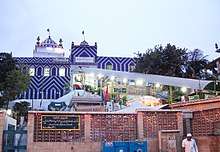Abdullah Shah Ghazi
Abdullah Shah Ghazi (Arabic: عبد الله شاه غازي) (c. 720) was an eighth-century Muslim mystic and Sufi whose shrine is located in Clifton, an affluent seaside municipality in Karachi, in Sindh province of Pakistan.[1] His real name was Abdullah al-Ashtar. His father, Muhammad al-Nafs al-Zakiyya, was a descendant of the prophet, Muhammad, through his daughter Fatimah. He is known for his commanding oratory skills, amiable demeanor, and impressive posture.
- See also Ghazi and Gazi (disambiguation)

Martyrdom

One of the city’s foremost architects and historians, Sohial Lari, suggests (in his book, A History of Sindh) that Shah Ghazi was an Arab merchant who had come to Sindh with the first wave of Arab invaders. However, another noted historian, M. Daudpota, suggests that Ghazi arrived in the area from Iraq as a commander who, along with Muhammed Bin Qasim, fought Sindh’s Hindu ruler, Raja Dahir, in the seventh century.
He settled in Sindh along with his brother, Syed Misri Shah, and became a follower of Sufi strands of Islam. He was, however, ambushed by his enemies in a forest in the interior of Sindh and killed. The handful of followers that he had gathered carried his body all the way to the shores where he had first set foot in Sindh. They buried him on top of a hill near the area from where he had arrived on an Arab ship. This area now lies in the vicinity of Clifton and Sea View in Karachi. [2]
Shrine

The tomb is built on a high platform, though the body is kept in a subterranean crypt. The shrine is made of a high, square chamber and a green-and-white striped dome, decorated with Sindhi tilework, flags and buntings. Devotees to the shrine caress the silver railing around the burial place and drape it with garlands of flowers. The shrine is said to be particularly popular with Urdu-speakers and Punjabis, although the shrine is also visited by some Christian and Hindu community members.[3]
Until the early 1950s, the shrine was a small hut on top of a sandy hill in Clifton. The shrine was built, expanded and beautified by the then custodian of the shrine, Murshid Nadir Ali Shah of Sehwan Sharif in the mid-1950s.[4][5] Traditionally there has always been a devotional connection between the shrine of Abdullah Shah Ghazi in Karachi and the Nadir Ali Shah's Pathan Kafi in Sehwan Sharif.[6] The shrine expansion and pilgrims attracted the festivities, free meals for all and the devotional music such as Qawwali.[1] In 1962, the Auqāf department took administrative control of the shrine. In 2011, the shrine was handed over to a private company, M/s Bahria.[7] Bahria Town, a Pakistani construction giant, renovated the exterior of the shrine. This received a mixed response from the residents of Karachi.[8]
The Abdullah Shah Ghazi shrine was attacked in 2010 by militants who detonated two suicide bombs at the shrine, killing 10 and injuring 50.[3]
The shrine's management still provides two daily meals free to anyone in need.[1]
See also
- List of mausoleums and shrines in Pakistan
- Muhammad al-Nafs al-Zakiyya, descendant of Imam Hasan ibn Ali
- Nadir Ali Shah
- Gazi Pir
References
- Asim Butt (11 August 2005). "Pakistan's mystical Islam thrives". BBC News. Archived from the original on 8 May 2009. Retrieved 12 February 2018.
- https://www.dawn.com/news/1145799
- Paracha, Nadeem (23 November 2014). "Abdullah Shah Ghazi: The saviour saint". Dawn (newspaper). Retrieved 12 February 2018.
- "غازی بابا کے مزارکی تعمیر قلندری بزرگوں نے کی تھی". ummat.net (in Urdu). Archived from the original on 26 July 2018.
- "1290 سال پرانا مزار عبداللہ شاہ غازیؒ". ایکسپریس اردو. 4 August 2019. Retrieved 26 February 2020.
- Shaw, Isobel (1999). Pakistan Handbook. Pakistan: Moon Publications. p. 59. ISBN 0918373565.
- "Takeover of shrines: Private company to run Abdullah Shah Ghazi - The Express Tribune". tribune.com.pk. Retrieved 13 February 2018.
- "City Faith – Abdullah Shah Ghazi shrine revisited". thekarachiwalla.com. Retrieved 2 October 2019.